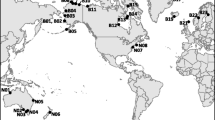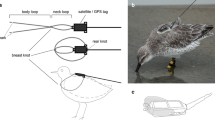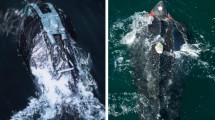Abstract
Satellite telemetry has become a common technique to investigate avian life-histories, but whether such tagging will affect fitness is a critical unknown. In this study, we evaluate multi-year effects of implanted transmitters on migratory timing and reproductive performance in shorebirds. Shorebirds increasingly are recognized as good models in ecology and evolution. That many of them are of conservation concern adds to the research responsibilities. In May 2009, we captured 56 female Black-tailed Godwits Limosa limosa limosa during late incubation in The Netherlands. Of these, 15 birds were equipped with 26-g satellite transmitters with a percutaneous antenna (7.8 % ± 0.2 SD of body mass), surgically implanted in the coelom. We compared immediate nest survival, timing of migration, subsequent nest site fidelity and reproductive behaviour including egg laying with those of the remaining birds, a comparison group of 41 females. We found no effects on immediate nest survival. Fledging success and subsequent southward and northward migration patterns of the implanted birds conformed to the expectations, and arrival time on the breeding grounds in 2010–2012 did not differ from the comparison group. Compared with the comparison group, in the year after implantation, implanted birds were equally faithful to the nest site and showed equal territorial behaviour, but a paucity of behaviours indicating nests or clutches. In the 3 years after implantation, the yearly apparent survival of implanted birds was 16 % points lower. Despite intense searching, we found only three eggs of two implanted birds; all were deformed. A similarly deformed egg was reported in a similarly implanted Whimbrel Numenius phaeopus returning to breed in central Alaska. The presence in the body cavity of an object slightly smaller than a normal egg may thus lead to egg malformation and, likely, reduced egg viability. That the use of implanted satellite transmitters in these large shorebirds reduced nesting propensity and might also lead to fertility losses argues against the use of implanted transmitters for studies on breeding biology, and for a careful evaluation of the methodology in studies of migration.
Zusammenfassung
Im Bauch implantierte Satellitensender beeinträchtigen bei großen Watvögeln eher Reproduktion und Überlebensfähigkeit als den Zug
Satellitentelemetrie hat sich zu einer gängigen Methode bei der Erforschung der Biologie von Vögeln entwickelt; ob allerdings eine solche Markierung die Fitness beeinträchtigt, ist ein kritischer unbekannter Faktor. In dieser Studie werteten wir die jahresübergreifenden Effekte implantierter Sender auf den zeitlichen Ablauf des Zuggeschehens und den Reproduktionserfolg bei Watvögeln aus. Watvögel werden zunehmend als geeignete Modelle für Ökologie und Evolution erkannt. Dass viele von ihnen schutzbedürftig sind, erhöht noch den Forschungsbedarf. Im Mai 2009 fingen wir in den Niederlanden 56 weibliche Uferschnepfen Limosa limosa limosa zu einem Zeitpunkt gegen Ende der Bebrütungsphase. Von diesen wurden 15 Vögel mit 26 g-Satellitensendern (7.8 % ± 0.2 SD der Körpermasse) mit einer perkutanen Antenne ausgestattet, welche operativ in die Leibeshöhle eingesetzt wurden. Wir verglichen die unmittelbare Nestüberlebensrate, den zeitlichen Ablauf des Zuggeschehens, die anschließende Brutorttreue sowie das Reproduktionsverhalten einschließlich der Eiablage mit denen der übrigen Vögel, einer Vergleichsgruppe aus 41 Weibchen. Wir konnten keinen Einfluss auf die unmittelbare Nestüberlebensrate feststellen. Der Ausfliegeerfolg und die anschließenden nach Süden beziehungsweise Norden gerichteten Zugmuster der implantierten Vögel entsprachen den Erwartungen, und die Ankunftszeit in den Brutgebieten in den Jahren 2010–2012 unterschied sich nicht von der Vergleichsgruppe. Gegenüber der Kontrollgruppe waren die implantierten Vögel im auf die Implantation folgenden Jahr genauso brutorttreu und zeigten vergleichbares Revierverhalten, dagegen aber kaum Verhaltensweisen, die auf Nester oder Gelege hindeuteten. In den drei auf die Implantation folgenden Jahren lag die scheinbare jährliche Überlebensrate von Vögeln mit Implantaten um 16 % niedriger. Trotz intensiver Suche fanden wir nur drei Eier von zwei implantierten Vögeln; diese waren alle missgebildet. Ein in ähnlicher Weise deformiertes Ei ist von einem Regenbrachvogel Numenius phaeopus mit einem vergleichbaren Implantat nach seiner Rückkehr ins Brutgebiet in Zentralalaska bekannt. So kann die Anwesenheit eines Objektes in der Leibeshöhle, welches etwas kleiner als ein normales Ei ist, zu Eimissbildungen und wahrscheinlich auch zu einer verringerten Lebensfähigkeit der Eier führen. Dass die Verwendung implantierter Satellitensender bei diesen großen Watvögeln die Nistbereitschaft reduziert und außerdem zu Fruchtbarkeitsausfällen führen könnte, spricht gegen die Verwendung implantierter Sender bei Studien zur Brutbiologie und für eine sorgfältige Prüfung der Methodik bei der Zugforschung.


Similar content being viewed by others
References
Barbraud C, Weimerskirch H (2012) Assessing the effect of satellite transmitters on the demography of the Wandering Albatross Diomedea exulans. J Ornithol 153:375–383
Barron DG, Brawn JD, Weatherhead PJ (2010) Meta-analysis of transmitter effects on avian behaviour and ecology. Methods Ecol Evol 1:180–187
Battley PF, Warnock N, Tibbitts TL, Gill RE Jr, Piersma T, Hassell CJ, Douglas DC, Mulcahy DM, Gartrell BD, Schuckard R, Melville DS, Riegen AC (2012) Contrasting extreme long-distance migration patterns in Bar-tailed Godwits Limosa lapponica. J Avian Biol 43:21–32
Burnham KP, Anderson DR (2002) Model selection and multimodel inference: a practical information-theoretic approach, 2nd edn. Springer, New York
Calvo B, Furness RW (1992) A review of the use and the effects of marks and devices on birds. Ring Migr 13:129–151
Driscoll PV, Ueta M (2002) The migration and behaviour of Eastern Curlews Numenius madagascariensis. Ibis 144(on-line):E119–E130
Esler D, Mulcahy DM, Jarvis RL (2000) Testing assumptions for unbiased estimation of survival of radiomarked Harlequin Ducks. J Wildl Manag 64:591–598
Falk K, Møller S (1995) Satellite tracking of high-arctic Northern Fulmars. Polar Biol 15:495–502
Falk K, Dall’Antonia L, Benvenutti S (2001) Mapping pre- and post-fledging foraging locations of thick-billed Murres in the North Water polynya. Ecography 24:625–632
Fast PL, Fast M, Mosbech A, Sonne C, Gilchrist HG, Deschamps S (2011) Effects of implanted satellite transmitters on behavior and survival of female Common Eiders. J Wildl Manag 75:1553–1557
Gill RE Jr, Tibbitts TL, Douglas DC, Handel CM, Mulcahy DM, Gottschalk JC, Warnock N, McCaffery BJ, Battley PF, Piersma T (2009) Extreme endurance flights by landbirds crossing the Pacific Ocean: ecological corridor rather than barrier? Proc R Soc Lond B 276:447–458
Groen NM (1993) Breeding site tenacity and natal philopatry in the Black-tailed Godwit Limosa l. limosa. Ardea 81:107–113
Groen NM, Kentie R, de Goeij P, Verheijen B, Hooijmeijer JCEW, Piersma T (2012) A modern landscape ecology of Black-tailed Godwits: habitat selection in southwest Friesland, The Netherlands. Ardea 100:19–28
Hart KM, Hyrenbach KD (2009) Satellite telemetry of marine megavertebrates: the coming of age of an experimental science. Endang Spec Res 10:9–20
Hupp JW, Ruhl GA, Pearce JM, Mulcahy DM, Tomeo MA (2003) Effects of implanted radio transmitters with percutaneous antennas on the behavior of Canada Geese. J Field Ornithol 74:250–256
Hupp JW, Pearce JM, Mulcahy DM, Miller DA (2006) Effects of abdominally implanted radiotransmitters with percutaneous antennas on migration, reproduction, and survival of Canada Geese. J Wildl Manag 70:812–822
International Wader Study Group (2003) Waders are declining worldwide. Wader Study Group Bull 101(102):8–12
Johnson M, Clarkson P, Goldstein MJ, Haig SM, Lanctot RB, Tessler DF, Zwiefelhofer D (2010) Seasonal movements, winter range use, and migratory connectivity of the Black Oystercatcher. Condor 112:731–743
Kentie R, Hooijmeijer JCEW, Trimbos KB, Groen NM, Piersma T (2013) Intensified agricultural use of grasslands reduces growth and survival of shorebird chicks. J Appl Ecol 50:243–251
Korschgen CE, Kenow KP, Gendron-Fitzpatrick A, Green WL, Dein FJ (1996) Implanting intra-abdominal radiotransmitters with external whip antennas in ducks. J Wildl Manag 60:132–137
Lourenço PM, Kentie R, Schroeder J, Groen NM, Hooijmeijer JCEW, Piersma T (2011) Repeatable timing of northward departure, arrival and breeding in Black-tailed Godwits Limosa l. limosa, but no domino effects. J Ornithol 152:1023–1032
MacKinnon J, Verkuil YI, Murray N (2012) IUCN situation analysis on East and Southeast Asian intertidal habitats, with particular reference to the Yellow Sea (including the Bohai Sea). Occasional paper of the IUCN species survival commission no. 47, IUCN, Gland
Márquez-Ferrando R, Hooijmeijer J, Groen N, Piersma T, Figuerola J (2011) Could Doñana, SW Spain, be an important wintering area for continental Black-tailed Godwits Limosa limosa limosa? Wader Study Group Bull 118:82–86
McMahon CR, Collier N, Northfield JK, Glen F (2011) Taking the time to assess the effects of remote sensing and tracking devices on animals. Anim Welf 20:515–521
Meyers PM, Hatch SA, Mulcahy DM (1998) Effect of satellite transmitters on the nesting behavior of Murres. Condor 100:172–174
Mulcahy DM, Esler D (1999) Surgical and immediate post-release mortality of Harlequin Ducks (Histrionicus histrionicus) implanted with abdominal radio transmitters with percutaneous antennae. J Zoo Wildl Med 30:397–401
Mulcahy DM, Gartrell B, Gill RE Jr, Tibbitts TL, Ruthrauff DR (2011) Coelomic implantation of satellite transmitters in the Bar-tailed Godwit (Limosa lapponica) and the Bristle-thighed Curlew (Numenius tahitiensis), using propofol, bupivacaine, and lidocaine. J Zoo Wildl Med 42:54–64
Pennycuick CJ, Fast PL, Ballerstädt N, Rattenborg N (2012) The effect of an external transmitter on the drag coefficient of a bird’s body, and hence on migration range, and energy reserves after migration. J Ornithol 153:633–644
Philips RA, Xavier JC, Croxall JP (2003) Effects of satellite transmitters on albatrosses and petrels. Auk 120:1082–1090
Piersma T (1984) Estimating energy reserves of Great Crested Grebes Podiceps cristatus on the basis of body dimensions. Ardea 72:119–126
Piersma T (2007) Using the power of comparison to explain habitat use and migration strategies of shorebirds worldwide. J Ornithol 148(Suppl. 1):S45–S59
R Development Core Team (2008) R: a language and environment for statistical computing. R Foundation for Statistical Computing, Vienna
Rappole JH, Tipton AR (1991) New harness design for attachment of radio transmitters to small passerines. J Field Ornithol 62:335–337
Robert M, Drolet B, Savard J-PL (2006) Effects of backpack radio-transmitters on female Barrow’s Goldeneyes. Waterbirds 29:115–120
Schekkerman H, Teunissen W, Oosterveld E (2008) The effect of ‘mosaic management’ on the demography of Black-tailed Godwit Limosa limosa on farmland. J Appl Ecol 45:1067–1075
Schroeder J, Lourenço PM, van der Velde M, Hooijmeijer JCEW, Both C, Piersma T (2008) Sexual dimorphism in plumage and size in Black-tailed Godwits (Limosa limosa limosa). Ardea 96:25–37
Schroeder J, Kentie R, van der Velde M, Hooijmeijer JCEW, Both C, Haddrath O, Baker AJ, Piersma T (2010) Linking intronic polymorphism on the CHD1-Z gene with fitness correlates in Black-tailed Godwits Limosa l. limosa. Ibis 152:368–377
Schroeder J, Piersma T, Groen NM, Hooijmeijer JCEW, Kentie R, Lourenço PM, Schekkerman H, Both C (2012) Reproductive timing and investment in relation to spring warming and advancing agricultural schedules. J Ornithol 153:327–336
Söhle IS (2003) Effects of satellite telemetry on Sooty Shearwater, Puffinus griseus, adults and chicks. Emu 103:373–379
Trimbos KB, Kentie R, van der Velde M, Hooijmeijer JCEW, Poley C, Musters CJM, de Snoo GR, Piersma T (2013) Intronic variation at the CHD1-Z gene in Black-tailed Godwits Limosa limosa limosa: correlations with fitness components revisited. Ibis 155:508–517
van den Brink V, Schroeder J, Both C, Lourenço PM, Hooijmeijer JCEW, Piersma T (2008) Space use by Black-tailed Godwits Limosa limosa limosa during settlement at a previous or a new nest location. Bird Study 55:188–193
van der Meer J, Piersma T (1994) Physiologically inspired regression models for estimating and predicting nutrient stores and their composition in birds. Physiol Zool 67:305–329
van der Velde M, Galama Y, Hooijmeijer J, Trimbos K, Piersma T (2011) Black-tailed Godwit Limosa limosa forensics: who laid a strangely shaped depredated egg? Limosa 84:155–161
Vandenabeele SP, Wilson RP, Grogan A (2011) Tags on seabirds: how seriously are instrument-induced behaviours considered? Anim Welf 20:559–571
Watts BD, Truitt BR, Smith FM, Mojica EK, Paxton BJ, Wilke AL, Duerr AE (2008) Whimbrel tracked with satellite transmitter on migratory flight across North America. Wader Study Group Bull 115:119–121
White GC, Burnham KP (1999) Program MARK: survival estimation from populations of marked animals. Bird Study 46:S120–S139
White CR, Cassey P, Schimpf NG, Halsey LG, Green JA, Portugal SJ (2013) Implantation reduces the negative effects of bio-logging devices on birds. J Exp Biol 216:537–542
Yang H-Y, Chen B, Barter M, Piersma T, Zhou C-F, Li F-S, Zhang Z-W (2011) Impacts of tidal land reclamation in Bohai Bay, China: ongoing losses of critical Yellow Sea waterbird staging and wintering sites. Bird Conserv Intern 21:241–259
Zwarts L, Bijlsma RG, van der Kamp J, Wymenga E (2009) Living on the edge. Wetlands and birds in a changing Sahel. KNNV, Zeist
Acknowledgments
For help in the field we thank the 2009–2012 “grutto” dream-teams comprised of N. Groen, K. Trimbos, P. Lourenço, Y. Galama, P. de Goeij, A. Rippen, R. van der Zee, E.-H. Mohamed El-Hacen, W. Vos, L. Schmaltz, K. Bowgen, S. Wouda, M. Verhoeven, C. Kuipers, M. Bulla, B. Verheijen, C. Poley, M. Sikkema, A. Allema, B. de Jong, H. Valkema, E. van der Velde, S. Kooistra, B. van den Boomgaard, R.-J. Hibma, S. Hobma, G. Hoekstra, and N. Bot. G. Hylkema kindly allowed his campervan “Pylger” to be turned into a mobile surgery unit. We thank the conservation authorities It Fryske Gea and Staatsbosbeheer and the local farmers for their co-operation and for allowing access to their grounds. The assistance of local volunteers in nest searching and reporting locations to us has been invaluable. Birdlife Netherlands made arrangements for daily and weekly updates about the project on their website. This work was financially supported by the Dutch Ministry of Agriculture, Nature Management and Food Quality, the Province of Fryslân, and the coalition Nederland-Gruttoland. We thank Dan Ruthrauff, Phil Battley and anonymous reviewers for help with the manuscript, and Bram Verheijen and Astrid Kant for the egg-photos. Any use of trade names or firm names is for descriptive purposes only and does not imply endorsement by the authors’ institutional affiliation.
Author information
Authors and Affiliations
Corresponding author
Additional information
Communicated by F. Bairlein.
Rights and permissions
About this article
Cite this article
Hooijmeijer, J.C.E.W., Gill, R.E., Mulcahy, D.M. et al. Abdominally implanted satellite transmitters affect reproduction and survival rather than migration of large shorebirds. J Ornithol 155, 447–457 (2014). https://doi.org/10.1007/s10336-013-1026-4
Received:
Revised:
Accepted:
Published:
Issue Date:
DOI: https://doi.org/10.1007/s10336-013-1026-4




